2005 RENAULT MEGANE check engine
[x] Cancel search: check enginePage 35 of 250
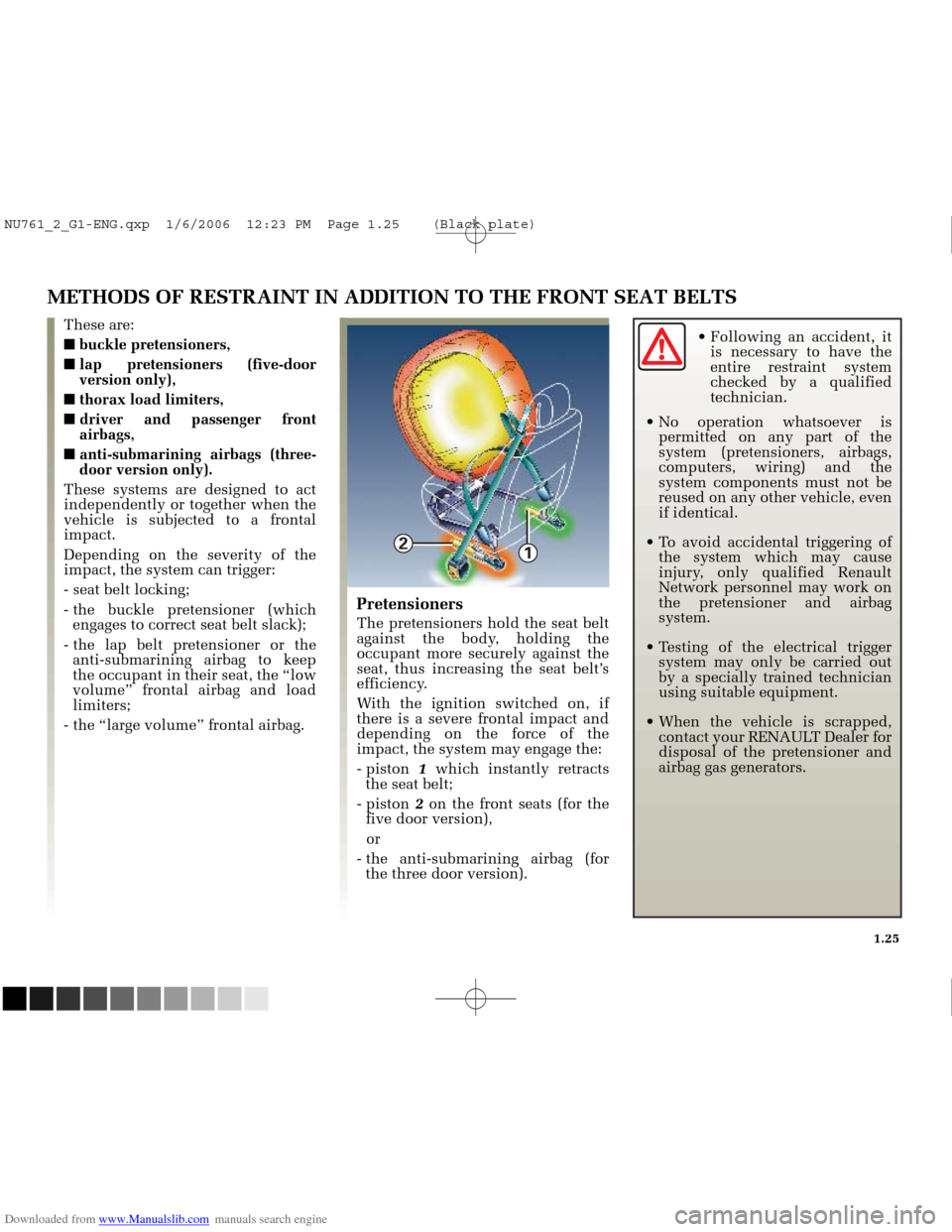
Downloaded from www.Manualslib.com manuals search engine
2
1
NU761_2_G1-FRA.qxd 10/11/05 15:53 Page 1.25
1.25
Following an accident, itis necessary to have the
entire restraint system
checked by a qualified
technician.
No operation whatsoever is permitted on any part of the
system (pretensioners, airbags,
computers, wiring) and the
system components must not be
reused on any other vehicle, even
if identical.
To avoid accidental triggering of the system which may cause
injury, only qualified Renault
Network personnel may work on
the pretensioner and airbag
system.
Testing of the electrical trigger system may only be carried out
by a specially trained technician
using suitable equipment.
When the vehicle is scrapped, contact your RENAULT Dealer for
disposal of the pretensioner and
airbag gas generators.
METHODS OF RESTRAINT IN ADDITION TO THE FRONT SEAT BELTS
These are:
■ buckle pretensioners,
■ lap pretensioners (five-door
version only),
■ thorax load limiters,
■ driver and passenger front
airbags,
■ anti-submarining airbags (three-
door version only).
These systems are designed to act
independently or together when the
vehicle is subjected to a frontal
impact.
Depending on the severity of the
impact, the system can trigger:
- seat belt locking;
- the buckle pretensioner (which engages to correct seat belt slack);
- the lap belt pretensioner or the anti-submarining airbag to keep
the occupant in their seat, the “low
volume” frontal airbag and load
limiters;
- the “large volume” frontal airbag.
Pretensioners
The pretensioners hold the seat belt
against the body, holding the
occupant more securely against the
seat, thus increasing the seat belt’s
efficiency.
With the ignition switched on, if
there is a severe frontal impact and
depending on the force of the
impact, the system may engage the:
- piston 1which instantly retracts
the seat belt;
- piston 2on the front seats (for the
five door version),
or
- the anti-submarining airbag (for the three door version).
NU761_2_G1-ENG.qxp 1/6/2006 12:23 PM Page 1.25 (Black plate)
Page 39 of 250

Downloaded from www.Manualslib.com manuals search engine
NU761_2_G1-FRA.qxd 10/11/05 15:53 Page 1.29
1.29
Following an accident, itis necessary to have the
entire restraint system
checked by a qualified
technician.
No operation whatsoever is permitted on any part of the
system (pretensioners, airbags,
computers, wiring) and the
system components must not be
reused on any other vehicle, even
if identical.
To avoid accidental triggering of the system which may cause
injury, only qualified RENAULT
Network personnel may work on
the pretensioner and airbag
system.
Testing of the electrical trigger system may only be carried out
by a specially trained technician
using suitable equipment.
When the vehicle is scrapped, contact your RENAULT Dealer for
disposal of the pretensioner and
airbag gas generators.
METHODS OF RESTRAINT IN ADDITION TO THE REAR SEAT BELTS
Depending on the vehicle, they
comprise:
■ seat belt pretensioners built into
the inertia reels,
■ load limiter.
These systems are designed to act
independently or together when the
vehicle is subjected to a frontal
impact.
There are two possibilities,
depending on the force of the
impact:
- protection is provided by the belt only;
- the pretensioner is triggered to rectify seat belt slack.
Rear seat belt pretensioners
This system is only operational
when the ignition is switched on.
If the vehicle is subjected to a severe
frontal impact, a device retracts the
seat belt, pulling the seat belt tight
against the body and thus improving
its effectiveness.
Load limiter
Above a certain severity of impact,
this mechanism is used to limit the
force of the belt against the body so
that it is at an acceptable level.
NU761_2_G1-ENG.qxp 1/6/2006 12:23 PM Page 1.29 (Black plate)
Page 41 of 250

Downloaded from www.Manualslib.com manuals search engine
NU761_2_G1-FRA.qxd 10/11/05 15:53 Page 1.31
1.31
ADDITIONAL METHODS OF RESTRAINTAll the warnings below are given so that airbag activation is not obstru\
cted in any way and also to prevent the risk of
serious injuries caused by items which may be dislodged when the airbag \
inflates.The airbag is designed to complement the action of the seat belt. Both t\
he airbags and seat belts are integral parts
of the same protection system. It is therefore essential to wear a seat \
belt at all times. If seat belts are not worn, the
occupants are exposed to the risk of serious injury in the event of an a\
ccident. It may also increase the risk of
minor superficial injuries occurring when the airbag is deployed, althou\
gh such minor injuries are always
possible with airbags.
If the vehicle should overturn or in the event of a rear impact, however\
severe, the pretensioners and airbags are not
always triggered. These systems may, however, be triggered by impacts to the vehicle underbody, e.g. from kerbs,
potholes, stones, etc.
Any operation on or modification to any part of the Airbag system (Ai\
rbags, pretensioners, electronic unit, wiring, etc.) is strictly prohibited (except by qualified RENAULT Network personnel).
To ensure that the system is in good working order and to avoid accidenta\
l triggering of the system which may cause injury, only qualified RENAULT Network personnel may work on the airbag system.
As a safety precaution, have the airbag system checked if your vehicle h\
as been involved in an accident, stolen or broken into.
When selling or lending the vehicle, inform the user of these points and\
hand over this handbook with the vehicle.
When scrapping your vehicle, contact your RENAULT Dealer for disposal of the gas generator(s).
NU761_2_G1-ENG.qxp 1/6/2006 12:23 PM Page 1.31 (Black plate)
Page 43 of 250
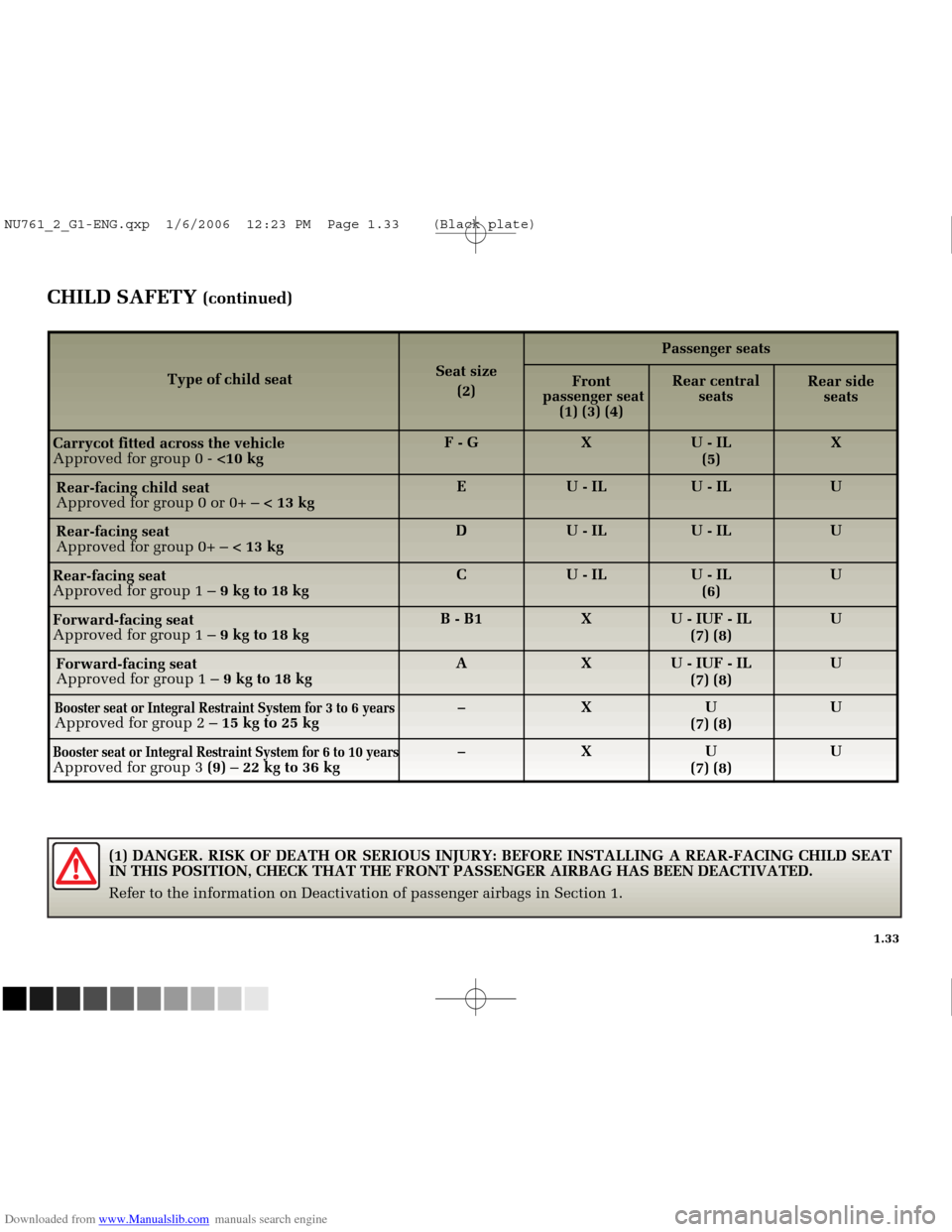
Downloaded from www.Manualslib.com manuals search engine
NU761_2_G1-FRA.qxd 10/11/05 15:53 Page 1.33
1.33
CHILD SAFETY (continued)
Type of child seat
Carrycot fitted across the vehicle
Approved for group 0 - <10 kg
Rear-facing seat
Approved for group 0+ – < 13 kg
Rear-facing child seat
Approved for group 0 or 0+ –
< 13 kg
Rear-facing seat
Approved for group 1 – 9 kg to 18 kg
Forward-facing seat
Approved for group 1 – 9 kg to 18 kg
Forward-facing seat
Approved for group 1 –
9 kg to 18 kg
Booster seat or Integral Restraint System for 6 to 10 yearsApproved for group 3 (9) – 22 kg to 36 kg Seat size
(2) Passenger seats
E
F - G
–
A
B - B1
C
D
X X X
U - IL
U - IL U - IL X
Front
passenger seat (1) (3) (4)
U
(7) (8)
U - IUF - IL
(7) (8)
U - IUF - IL
(7) (8)U - IL
(6)
U - IL
U - IL U - IL
(5)
Rear central
seats
U U U U U UX
Rear side
seats
Booster seat or Integral Restraint System for 3 to 6 yearsApproved for group 2 – 15 kg to 25 kg
–XU(7) (8)U
(1) DANGER. RISK OF DEATH OR SERIOUS INJURY: BEFORE INSTALLING A REAR-\
FACING CHILD SEAT
IN THIS POSITION, CHECK THAT THE FRONT PASSENGER AIRBAG HAS BEEN DEACTIV\
ATED.
Refer to the information on Deactivation of passenger airbags in Section\
1.
NU761_2_G1-ENG.qxp 1/6/2006 12:23 PM Page 1.33 (Black plate)
Page 44 of 250
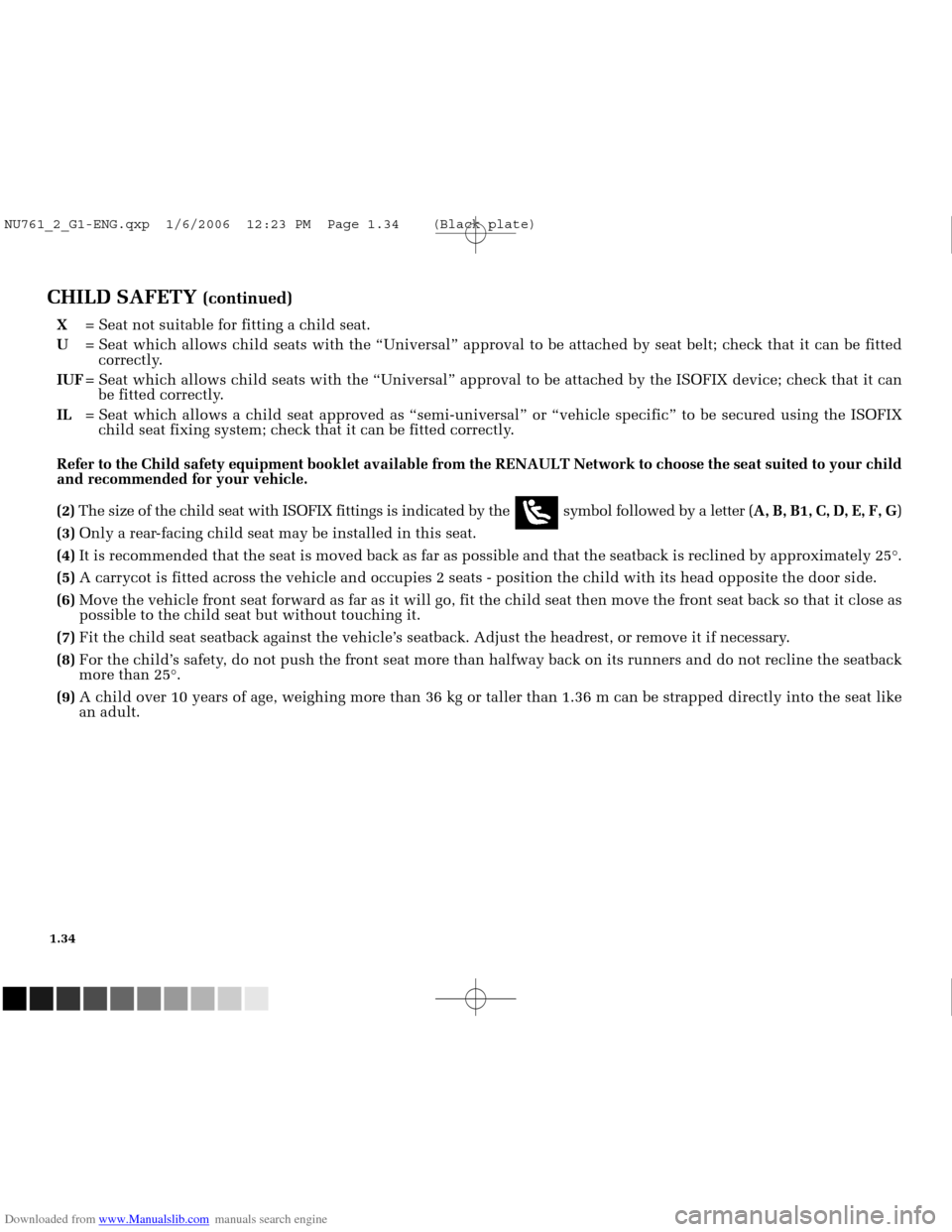
Downloaded from www.Manualslib.com manuals search engine
NU761_2_G1-FRA.qxd 10/11/05 15:53 Page 1.34
1.34
CHILD SAFETY (continued)
X= Seat not suitable for fitting a child seat.
U = Seat which allows child seats with the “Universal” approval to be \
attached by seat belt; check that it can be fitted
correctly.
IUF = Seat which allows child seats with the “Universal” approval to be \
attached by the ISOFIX device; check that it can
be fitted correctly.
IL = Seat which allows a child seat approved as “semi-universal” or “\
vehicle specific” to be secured using the ISOFIX
child seat fixing system; check that it can be fitted correctly.
Refer to the Child safety equipment booklet available from the RENAULT N\
etwork to choose the seat suited to your child
and recommended for your vehicle.
(2) The size of the child seat with ISOFIX fittings is indicated by the symbol followed by a letter ( A, B, B1, C, D, E, F, G)
(3) Only a rear-facing child seat may be installed in this seat.
(4) It is recommended that the seat is moved back as far as possible and tha\
t the seatback is reclined by approximately 25°.
(5) A carrycot is fitted across the vehicle and occupies 2 seats - position \
the child with its head opposite the door side.
(6) Move the vehicle front seat forward as far as it will go, fit the child \
seat then move the front seat back so that it close as
possible to the child seat but without touching it.
(7) Fit the child seat seatback against the vehicle’s seatback. Adjust the headrest, or remove it if necessary.
(8) For the child’s safety, do not push the front seat more than halfway back on its runners and d\
o not recline the seatback
more than 25°.
(9) A child over 10 years of age, weighing more than 36 kg or taller than 1.\
36 m can be strapped directly into the seat like
an adult.
NU761_2_G1-ENG.qxp 1/6/2006 12:23 PM Page 1.34 (Black plate)
Page 48 of 250
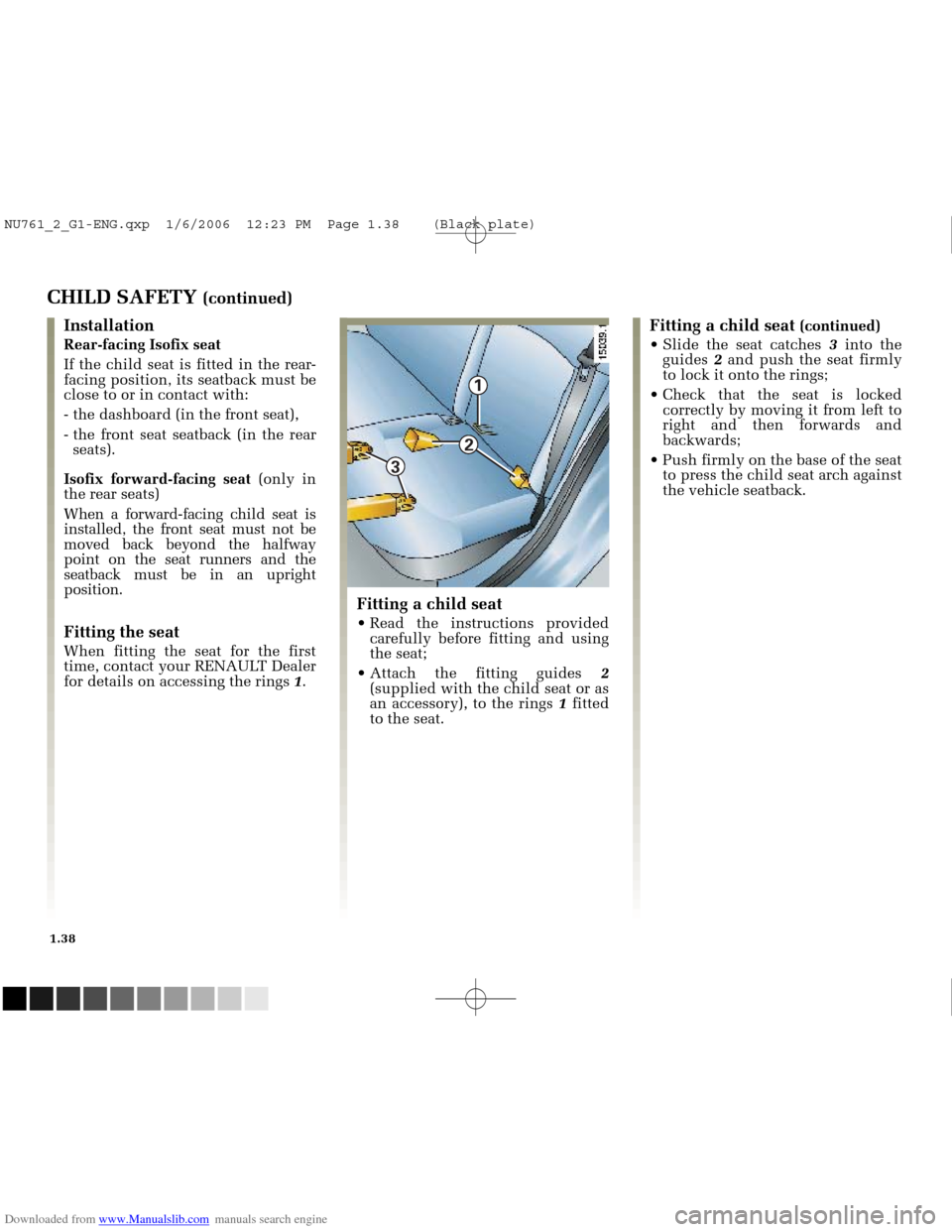
Downloaded from www.Manualslib.com manuals search engine
1
3
2
NU761_2_G1-FRA.qxd 10/11/05 15:53 Page 1.38
1.38
CHILD SAFETY (continued)
Installation
Rear-facing Isofix seat
If the child seat is fitted in the rear-
facing position, its seatback must be
close to or in contact with:
- the dashboard (in the front seat),
- the front seat seatback (in the rear seats).
Isofix forward-facing seat (only in
the rear seats)
When a forward-facing child seat is
installed, the front seat must not be
moved back beyond the halfway
point on the seat runners and the
seatback must be in an upright
position.
Fitting the seat
When fitting the seat for the first
time, contact your RENAULT Dealer
for details on accessing the rings 1.
Fitting a child seat (continued)
Slide the seat catches 3into the
guides 2and push the seat firmly
to lock it onto the rings;
Check that the seat is locked correctly by moving it from left to
right and then forwards and
backwards;
Push firmly on the base of the seat to press the child seat arch against
the vehicle seatback.
Fitting a child seat
Read the instructions providedcarefully before fitting and using
the seat;
Attach the fitting guides 2
(supplied with the child seat or as
an accessory), to the rings 1fitted
to the seat.
NU761_2_G1-ENG.qxp 1/6/2006 12:23 PM Page 1.38 (Black plate)
Page 50 of 250
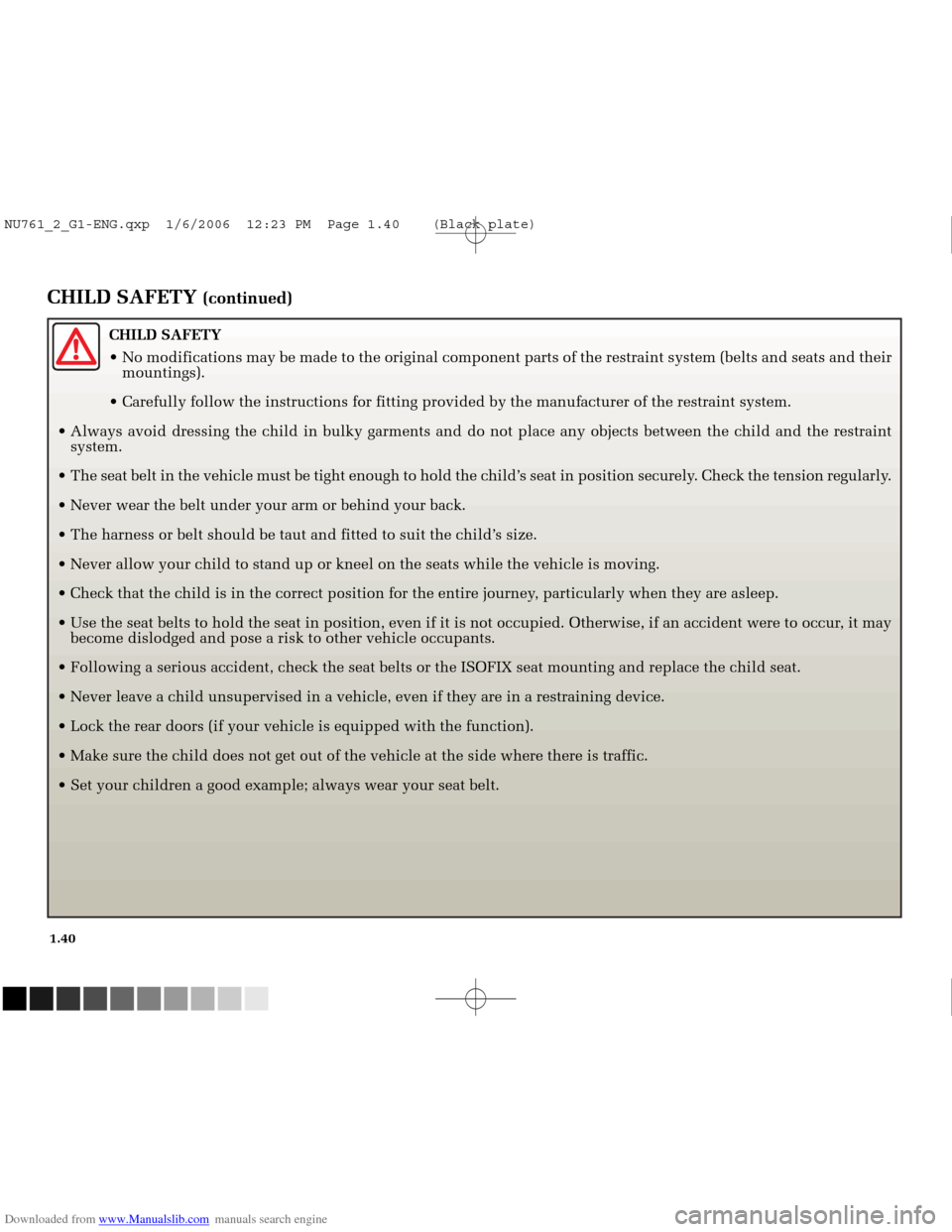
Downloaded from www.Manualslib.com manuals search engine
NU761_2_G1-FRA.qxd 10/11/05 15:53 Page 1.40
1.40
CHILD SAFETY (continued)
CHILD SAFETY
No modifications may be made to the original component parts of the rest\
raint system (belts and seats and theirmountings).
Carefully follow the instructions for fitting provided by the manufactur\
er of the restraint system.
Always avoid dressing the child in bulky garments and do not place any o\
bjects between the child and the restraint system.
The seat belt in the vehicle must be tight enough to hold the child’s seat in position securely. Check the tension regularly.
Never wear the belt under your arm or behind your back.
The harness or belt should be taut and fitted to suit the child’s size.
Never allow your child to stand up or kneel on the seats while the vehic\
le is moving.
Check that the child is in the correct position for the entire journey, particularly when they are asleep.
Use the seat belts to hold the seat in position, even if it is not occ\
upied. Otherwise, if an accident were to occur, it may become dislodged and pose a risk to other vehicle occupants.
Following a serious accident, check the seat belts or the ISOFIX seat mo\
unting and replace the child seat.
Never leave a child unsupervised in a vehicle, even if they are in a res\
training device.
Lock the rear doors (if your vehicle is equipped with the function).
Make sure the child does not get out of the vehicle at the side where th\
ere is traffic.
Set your children a good example; always wear your seat belt.
NU761_2_G1-ENG.qxp 1/6/2006 12:23 PM Page 1.40 (Black plate)
Page 51 of 250

Downloaded from www.Manualslib.com manuals search engine
2
3
1
NU761_2_G1-FRA.qxd 10/11/05 15:53 Page 1.41
1.41
DANGER
Since front passenger airbag
triggering and the position
of a rear-facing child seat
are incompatible, it is not
permitted to install such a seat in
this position unless the vehicle is
fitted with an airbag deactivation
device. The child may suffer very
serious injuries if the airbag is
deployed.
The label (on the dashboard) and
the markings (on the sun visor)
remind you of these instructions.
CHILD SAFETY (continued)
Deactivating the front passenger
airbags
(if fitted )
To fit a rear-facing child seat on the
front passenger seat, it is essentialto
deactivate the front passenger seat
additional restraint systems (frontal
and side airbags and lap
pretensioner) and the anti-
submarining airbag (for the three-
door version). To deactivate the airbags:
when the
vehicle is stationary, push and turn
lock 1to the OFF position.
With the ignition on, it is essential
to check that warning light 2,
AIRBAG OFF , is illuminated on the
instrument panel or on centre
display 3 and, depending on the
vehicle, check that the message
“passenger airbag OFF” is
displayed.
This light remains continuously lit
to let you know that you can fit a
child seat.
NU761_2_G1-ENG.qxp 1/6/2006 12:23 PM Page 1.41 (Black plate)